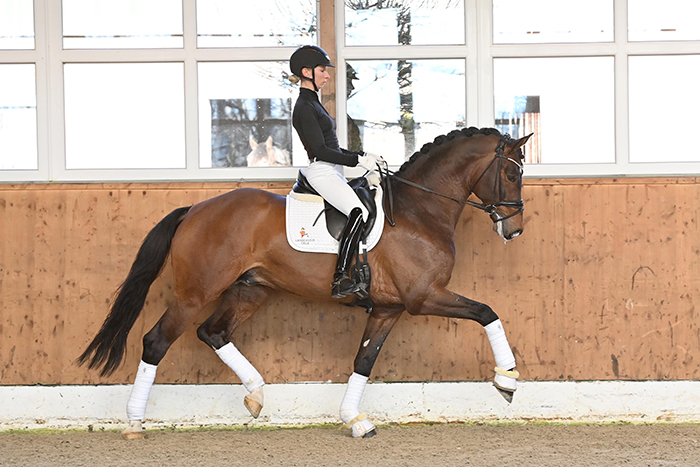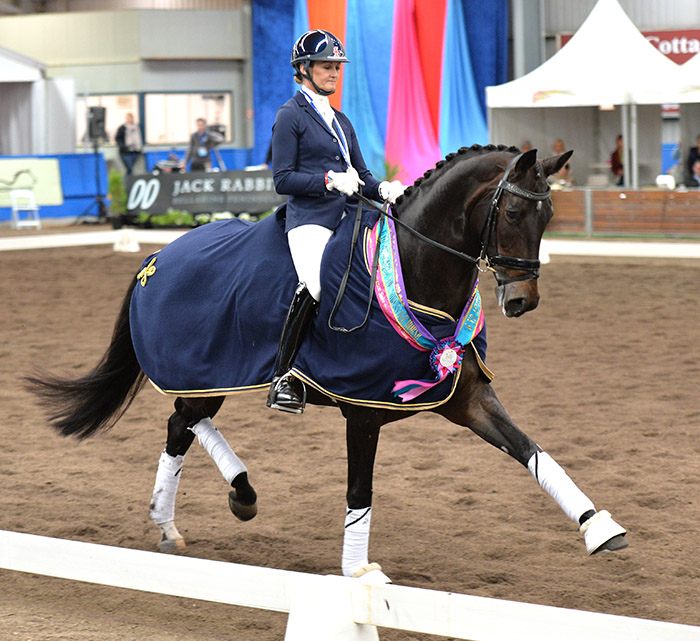
Donna Elena, a winner as a young horse at Dressage with the Stars
Back in 2016, Maree Tomkinson, one of Australia’s elite dressage riders, trained with one of the world’s most talented instructors, Princess Nathalie zu Sayn Wittgenstein.
Nathalie is an instructor who regularly ranked in the world’s top ten with appearances at Games, Euros, and the WEG (medal even), but she can also talk-the-talk as a result of her time studying with first Kyra Kyklund, then Klaus Balkenhol, and more recently with Kyra’s partner Richard White, and Kyra herself. And recently has trained many of the successful Danish team members.
Maree is riding Donna Elena, by Don Schufro out of a Bolero mare. She had just turned six…’
Into the arena and Maree is working her in trot on the left rein, and Nathalie is singing the age-old refrain, inside leg to outside hand:
“Make sure she stays upright to the inside leg, push her a little more out to the outside rein, feel you can make a half halt with the outside rein and still keep her flexed to the inside. You have to use your inside leg to get her on the outside rein so she learns from the beginning to give on the topline.”
In the canter work, Nathalie wanted Maree to get the mare more active behind:
“Occupy the outside hind leg, so it stays snappy and active, loosen her once to the outside, so she stays in front of the outside hind leg. Loosening her to the outside makes her more straight.”

Straight and supple at the same time…
“Make sure from the beginning that you have suppleness through her body so you can get the connection with the outside rein. Bend her to the inside to get the connection to the outside rein – but you won’t get that connection just bending her to the outside. Go on a circle, get the bend to the inside so you really feel you can make a half halt with the outside hand.”
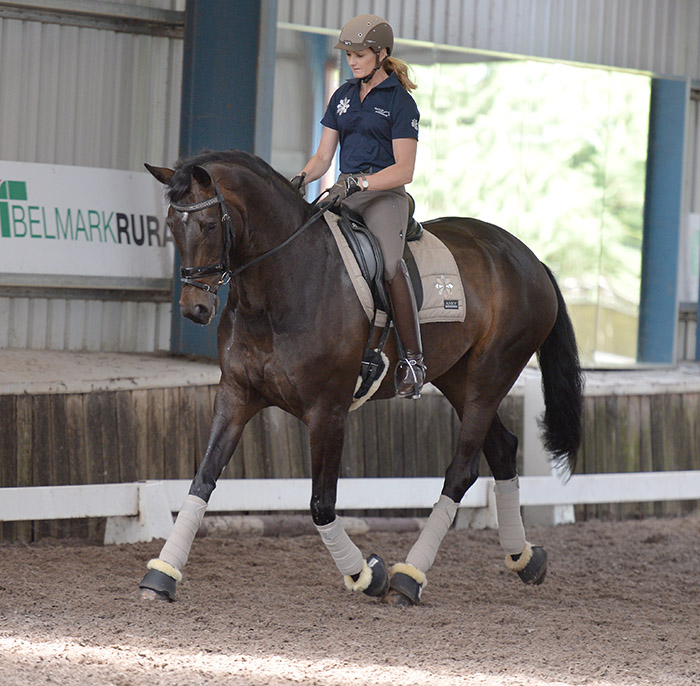
But still maintain the activity:
“Keep the hind leg engaged, quick, reactive behind, come with your leg and feel the reaction behind.”
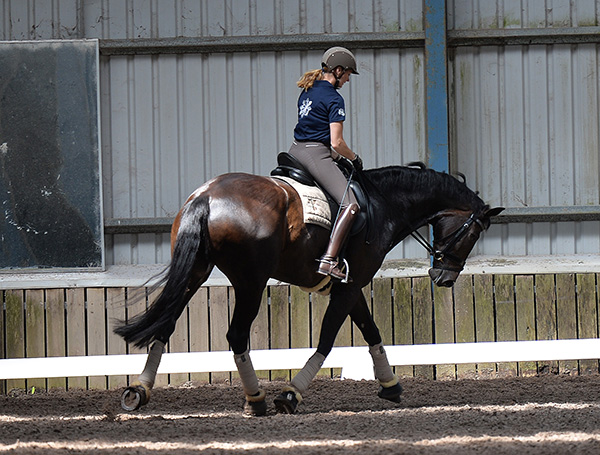
More behind, but less in front…
“Let her come down in front, her neck has to come up as a result of the activity of the hind legs. Let her lower with the neck, play with the position, and then bring her up by riding her from behind, and she will soften in her topline. Bring her down, she has to give the bottom of her neck, down with your hands and ride with your leg.”
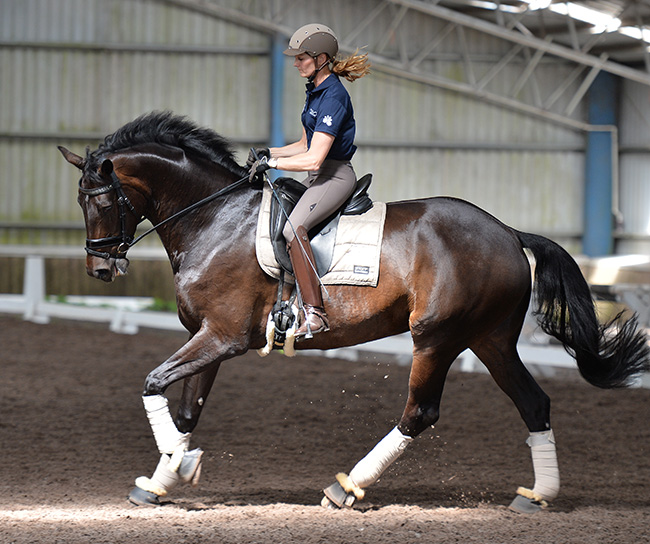
And Maree had to ride her half halts positively:
“Keep riding her with your leg in the half halt, so she is snappy and active in the half halt. Use the half halt to bring her back on her hind leg. In the half halt close her in from behind to make her more active with her hind leg.”
“It’s no good to hold her up and keep her there, she has to come from the hind legs through the back and up, when she is strong enough to go there, and for that you must be able to ride her both up and down.”
After the canter work, Maree fell into the trap that so many fabulous movers invite, they love to float, to use their amazing suspension, to produce pissage.
“That trot is too forward to be passage, and too passagy to be trot, Either move forward, or move back.”
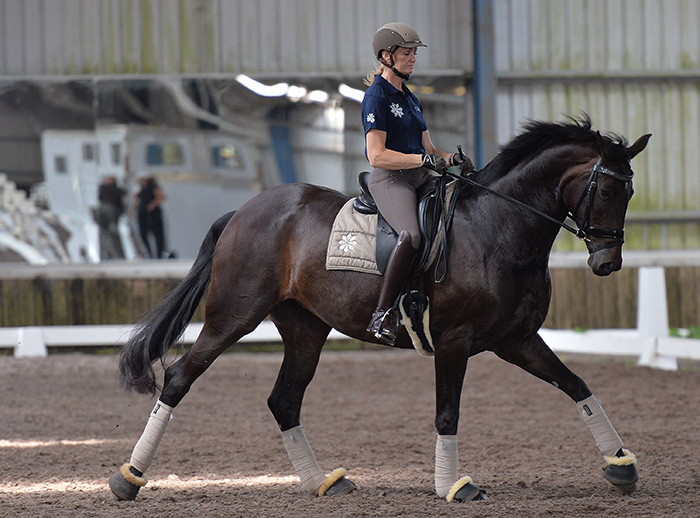
Some wind-down canter: “Use the outside rein and make her straight, even if you make her lower in the neck. Lower the neck to get more jump, and use that jump to push the withers up and she will be more up in the canter. When she tries to drop her belly like that, close your foot, so she stays up.”
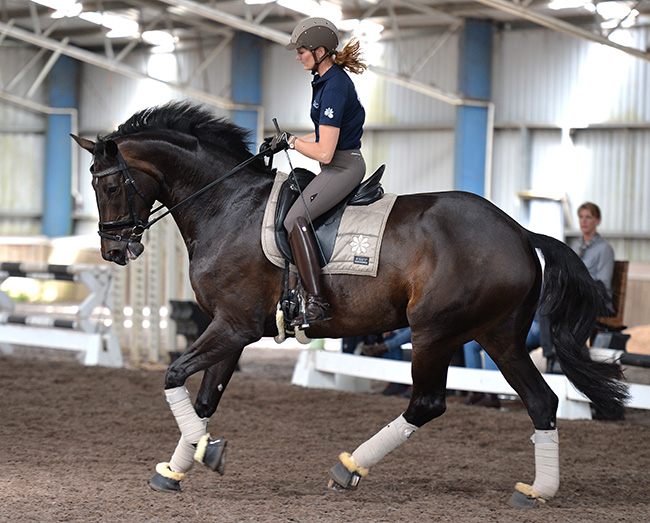
So my first question to Nathalie – It really is just the same old, same old, inside leg to outside hand…
“Well training horses hasn’t changed really, it’s the same…”
You don’t think it is more dangerous now, we have these super well bred, super moving horses, and they allow riders to get away with things they ought not get away with?
“Of course, and that’s the dangerous part because still a horse has to be really supple and through to both sides. We all know a horse has a good, and a not so good side, and that’s what you have to make equal, and develop the horse more. And of course, riders try to hide this behind spectacular movement, but those spectacular horses also have to be trained in a good way.”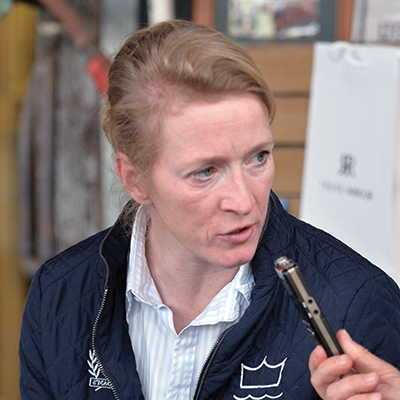
Well, they do now…
“When you think on it, times have definitely changed. In the Salinero time, that was definitely about tension and not-so-nice riding, now with Helen Langehanenberg, and Charlotte (Dujardin) of course, times have changed again, and I think into the right direction. It’s all about harmony, and horses have to be through. Okay they ride amazing moving horses, for me Valegro is the best horse in the world because he has everything. He is supple and he’s got movement, it all looks really really easy.”
Do you think Valegro is such a super horse, or just a nice horse brilliantly trained and ridden?
“If you speak to Carl (Hester), he will tell you he was quite a normal horse as a young horse, but he still has the ability to use his body in the way he does, that is not something you can teach him to do. He is naturally an athlete. Of course maybe if someone else had got him, we would never have seen him – so he was in the right time with the right rider, right trainer, and has bloomed into this fantastic world class horse.”
Do you think it is hard for riders in Australia. When you grew up, you were taught first by Kyra, then by Klaus, then Richard and Kyra again, there was never a time when you weren’t being looked at hard, and critically…
“That’s the whole point. You don’t have to always have those fantastic trainers, but you just have to have eyes on the ground, knowing in which direction you have to head. There are a lot of ways to Rome, and you can try different ways, but if you don’t know if you are really heading to Siberia, then it is difficult, that’s where you need the eyes on the ground.”
You say there are many ways to Rome, but really when we look at all the very good trainers of our time, they all have the same road map…
“It is the same road map definitely, but you do need the right person on the ground, it doesn’t necessarily have to be Kyra Kyrklund or Klaus Balkenhol, but just somebody who knows the correct direction to Rome, then it can be a little bit via Munich or via Berlin, but it is important to have that person to tell you when it is right or when it is wrong.”
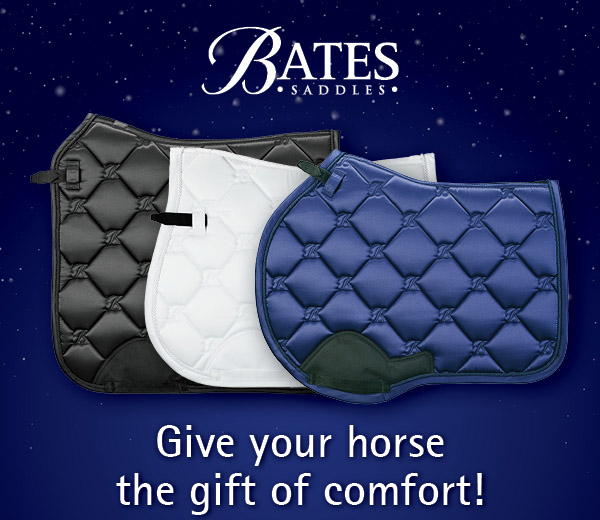
Maree talks about Donna Elena
Where did you find this extraordinarily talented creature?
“She was at Johannes Westendarp’s stable. He’s my go-to person for young horses. Anywhere you go to buy young horses, in the end you are the person who picks the horse, and you can pick the right horse for yourself, or you can choose the wrong horse for yourself. It is a very personal thing, and it has to be the right horse for you.”
You are very good at finding them, what is the set of criteria that you take with you when you go shopping?
“It’s a bit of a give and take thing because no horse is perfect. Diamantina had an awesome walk and an awesome canter, a bit of a normal trot. She was always a bit short and high in the neck, and she always had a bit of a marey attitude, so I knew from the beginning she wasn’t going to be super easy, but she was super talented and the canter and the walk were so good. They all have good things and bad things. Donna Elena was about a foot higher behind than she was in front, so that was always a risk. You had to hope that the front end would come up and match the back end, which it has, thank god. She also had a little bit of a right rein issue, which has also become a lot better. But she had a very good walk, a very good trot and a very good canter, three good paces and I guess for me, it is the feeling I get in the saddle through their back. If the horse is good in the back, if I feel that they really find it easy to carry the hind leg and stay underneath me and have a really good feeling, then I can work with the horse.”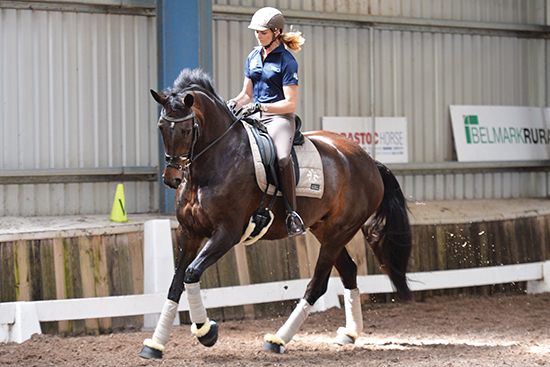
What was the take-home for you out of the lesson with Nathalie?
“Just getting her a little bit more over the back. Keeping her up in the wither is something we work on all the time, and Nathalie picked up on that really quickly, which was great. Working on lowering the neck a little, getting her more up in the back and more adjustable. That was the most important thing for me – and I have to be careful with the trot, not to let it get too much suspension in it. She can very easily carry a lot of suspension in that trot and I have to be careful with a six year old, not to let that happen.”
This article first appeared in the April 2016 issue of THM.
Breeding your own dressage star in Australia? Go to www.ihb.com.au
and select a stallion with the top European bloodlines – like Fusionist – or choose from many many more!
